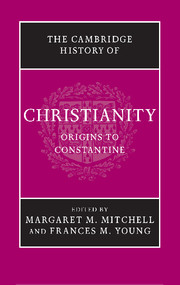Book contents
- Frontmatter
- Prelude: Jesus Christ, foundation of Christianity
- Part I The Political, Social and Religious Setting
- Part II The Jesus Movements
- Part III Community Traditions and Self-Definition
- Part IV Regional Varieties of Christianity in the First Three Centuries
- 15 From Jerusalem to the ends of the earth
- 16 Overview: the geographical spread of Christianity
- 17 Asia Minor and Achaea
- 18 Egypt
- 19 Syria and Mesopotamia
- 20 Gaul
- 21 North Africa
- 22 Rome
- Part V The Shaping of Christian Theology
- Part VI ‘Aliens’ become Citizens: towards Imperial Patronage
- Conclusion: retrospect and prospect
- Bibliographies
- Index
- Map 1. The Roman Empire in the time of Marcus Aurelius
- References
19 - Syria and Mesopotamia
from Part IV - Regional Varieties of Christianity in the First Three Centuries
Published online by Cambridge University Press: 28 March 2008
- Frontmatter
- Prelude: Jesus Christ, foundation of Christianity
- Part I The Political, Social and Religious Setting
- Part II The Jesus Movements
- Part III Community Traditions and Self-Definition
- Part IV Regional Varieties of Christianity in the First Three Centuries
- 15 From Jerusalem to the ends of the earth
- 16 Overview: the geographical spread of Christianity
- 17 Asia Minor and Achaea
- 18 Egypt
- 19 Syria and Mesopotamia
- 20 Gaul
- 21 North Africa
- 22 Rome
- Part V The Shaping of Christian Theology
- Part VI ‘Aliens’ become Citizens: towards Imperial Patronage
- Conclusion: retrospect and prospect
- Bibliographies
- Index
- Map 1. The Roman Empire in the time of Marcus Aurelius
- References
Summary
The New Testament book of Acts claims that ‘in Antioch the disciples were for the first time called Christians’ (Acts 11:26). Paul’s letter to the Galatians and further statements from Acts present Antioch as the base from which the first Christians launched their missions out into the larger Mediterranean world. These texts depict Antioch as the place where the tensions of identity associated with Gentile and Jewish converts were first confronted and subsequently argued with the earliest believers still located in Jerusalem. Both Peter and Paul travelled to and from Antioch as they carried out their respective missions, and by virtue of their shared associations with the city granted it singular status for Christians thereafter.
The familiar trajectory of Christian history traces the movement of the gospel from Jerusalem, through Antioch, westward to Rome. But Antioch was also the gateway east. Indeed, if the Abercius inscription from Hieropolis in Phrygia is Christian, it appears to attest to active Christian communities by the late second century as far east as the city of Nisibis on the Roman–Persian border. This chapter will attempt to trace the emergence of Christianity in the region broadly known as Syria: stretching from the coastal ports outside Antioch east to Palmyra and Persia, and from Mesopotamia in the north down to Palestine. While some of our most important early Christian writings survive from this region, material evidence is scarce. We have neither the abundance of inscriptions that survived in Asia Minor, nor the wealth of documentary and literary evidence found in Egypt.
Keywords
- Type
- Chapter
- Information
- The Cambridge History of Christianity , pp. 351 - 365Publisher: Cambridge University PressPrint publication year: 2006

